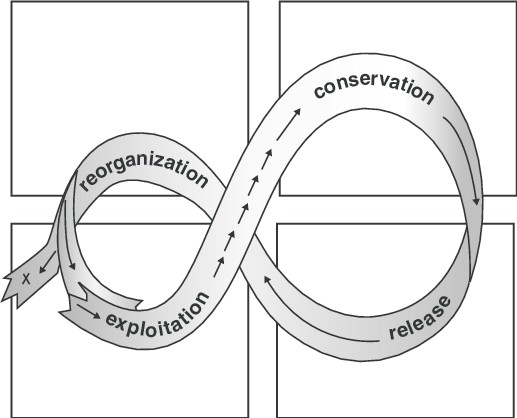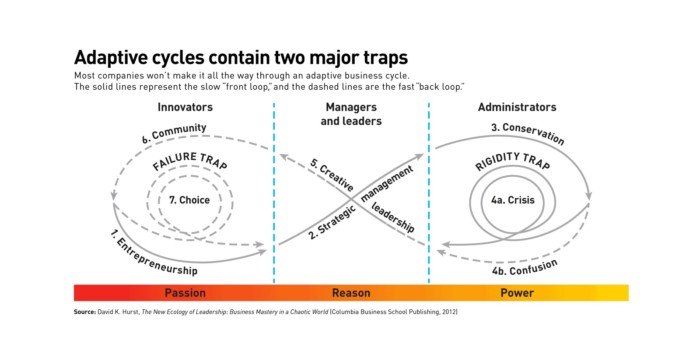Understanding the idea of business ecosystems and the adaptive cycle gives you a competitive advantage because it allows you to anticipate changes. However, this type of ecosystem requires businesses to work together to maintain stability. Intuitive leaders capitalize on the benefits of working within a business ecosystem.
This article will define business ecosystems, the phases within the adaptive cycle, highlight traps that can potentially lead to failure, and strategies to ensure success. If you can identify where your business falls on the adaptive cycle, you can implement strategies to make your success inevitable.
What Exactly is a Business Ecosystem?


In a business ecosystem, two or more businesses work together to create and share value for a group of customers at the same time.
The whole idea of business ecosystems is that working together can create more value than working independently. Working together means that members within the ecosystem cooperate and compete, leading to a thriving environment. Over time, businesses within this environment co-evolve and naturally align themselves.
The motivation behind this environment is shared interests and goals. A great example is Apple, Fitbit, and Garmin, joining a business ecosystem that focuses on fitness apps.
Unlike natural ecosystems, business ecosystems don’t have a long shelf life. Business ecosystems’ average thriving period appears to be within ten years. The best chance of extending the thriving period comes from the work of Canadian ecologist C.S Holling.
The Adaptive Cycle
The adaptive cycle highlights the ongoing process of maintaining a natural ecosystem through repeated destruction and re-birth. This cycle has four main phases, which happen at different times for each business.
There’s a period of extended growth in the beginning stage of a startup, also known as exploration and conservation. For example, a new startup specializing in IT support opens in Austin, Texas. Since Austin’s tech market is flourishing, this startup experiences rapid growth at its onset (exploration).
Then Covid-19 hits and causes businesses to shift to remote work. This disruption results in a new need, which causes the market to shift towards IT services. As competition for resources hits an all-time high, the startup enters a conservation period.


Eventually, the startup arrives at destruction and renewal periods – or release and reorganization. Natural evolution leads to mature organizations dominating the market. Their influence caps the sector’s growth potential, which means older businesses must break apart and recycle their resources to make room for new businesses.
Then, the adaptive cycle repeats itself.
Successful businesses can go through the adaptive cycle several times within ten years because they don’t fall prey to two distinct traps.
Adaptive Cycle Traps
The adaptive business cycle contains two traps businesses can fall into – the failure (poverty) trap or the rigidity (competence) trap. While these traps may cause irreparable damage to your business, there are strategies you can implement to avoid this.


Failure (Poverty) Trap
This trap is all about poor planning and adaptation to the current environment. Three issues can lead to failure: lack of market need, not having enough money, and creating the wrong team.
Lack of Market Need
There are many reasons why new businesses fail—one example includes the lack of market need. Once Apple released the iPod, Microsoft responded with the Zune in 2006. Unfortunately, the Zune didn’t offer customers anything of real value. Microsoft then discontinued the Zune five years later.
Conducting market research before launching your product can save resources by identifying your target market and receiving consumer feedback about your product. This feedback can help improve your product to meet the consumer’s specific needs.
Not Having Enough Money
Another failure trap involves not having enough money, especially during startup. While some businesses overcome this trap to become highly successful, the majority simply cannot.
Nearly 61 percent of businesses did not have an official annual budget. Thus, creating an annual budget for your business can help forecast potential funding issues, giving you time to prepare. If you do not know about financial planning, it’s best to hire a bookkeeper for your business.
Creating the Wrong Team
Lastly, creating the wrong team can lead to the failure trap. Fortune Magazine named Enron as America’s most innovative business for six years straight. Unfortunately, a team of self-serving executives led to Enron’s downfall resulting in over 20,000 employees losing their jobs and $1.2 billion in 401k savings.
A strategy for creating an efficient team is having them create a shared vision. Then clarifying each member’s expectations, roles, and responsibilities will create accountability. Lastly, promoting team values such as acceptance and open communication will foster trust and psychological safety.
Rigidity (Competence) Trap
In some cases, businesses refuse to innovate because their way of doing things already brings them success. Kodak, a technology company that led the photographic market, is the most well-known example of the rigidity trap. Kodak was so focused on film that they completely missed the disruption caused by digital pictures. This trap resulted in Kodak’s bankruptcy in 2012.
Businesses must adapt to changes to remain competitive in their market. Leaders must promote innovation as an essential business value. Then, leaders must model the desired behaviors, such as creativity, and experiment with new ways of doing things. Leaders must publicly praise the desired behavior as employees begin mirroring these behaviors.
These lessons are powerful examples that highlight the law of the ecosystem – stability and change share a symbiotic relationship. Stability lies in continuous change, meaning businesses won’t survive unless they renew themselves.
Conclusion
There are several advantages of learning more about the adaptative cycle in business. If you know which phase your business is currently in, you can model best practices to ensure survival.
You can also identify and use your business ecosystem to your advantage. Your business can collaborate with competitors to combine innovation and resources to produce an elite product.
Lastly, knowing where your business is on the adaptive cycle can help detect potential traps. You can enforce various strategies to ensure your business’s survival throughout each phase.
It’s all about remaining aware. The more you become aware of your environment, the better you can adapt to changes.
Bianca Cardenas, M.S., Ph.D., is a Fellow in Executive Assessment and Consulting with Leadership Worth Following. Dr. Bianca Cardenas empowers leaders to transcend competition by helping them unlock their people's potential.

